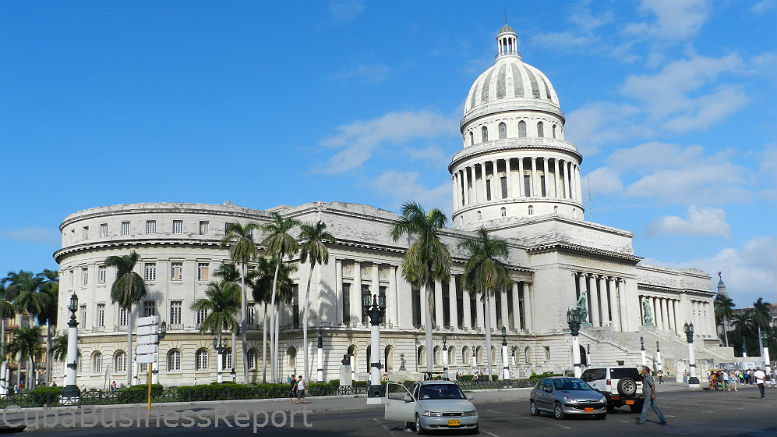El Capitolio Nacional – Havana’s National Capital building is one of the most photographed buildings in the city and rightly so. It is one of the greatest symbolic examples of historical architecture in Old Havana. Once upon a time, the Capitolio was open to the public, but that was back in the old days until 2010. Since that year, the Office of the City Historian, Cuban craftsmen, Italian and Spanish investors have been working to restore the building to its former glory.
Once upon a time, there was an elegant café on the Capitolio terrace. It was open to the public. It was shaded by the massive Roman columns in the front. The café was decorated with the green fronds of potted palms. Tables were set with white linens and arched-back wooden chairs stood on pristine marble floors. If you looked upwards, you could see a ceiling of marble with delicately carved pink roses on a background of blue squares.
It was here you could sit and find respite from the oppressive heat. You could people watch on del Prado. In the café, you might have felt absolutely and fabulously alive, connected to everything because “this is Havana.” You know the feeling I’m talking about.
You might also end up thinking too, “life is beautiful.” It was that kind of place. Time stood still. There was no hurry to leave. A waiter, dressed in a white shirt and black trousers, could be seen now and then, carrying a tray of cold drinks or coffee. Waiters would appear and then vanish in the manner of customary professional silence. There was even Wifi, though I’m not sure why anyone would have needed it. Those were the old days. I’m waxing nostalgic here, looking over old photographs taken with a camera in the days before digital.
I first enjoyed coffee in this wonderful café in 1999. Like many who once fell in love with Havana, I returned again in 2002. Who wouldn’t want to go back to that café at the Capitolio with its offering of fine coffee, serenity and reflection, right in the busy center of all things?
The café was the kind of place where writers would write. Thinkers would think. Tourists would catch their breath. It was that kind of place.
Until 2010 the building and the café were open to tourists. There was no ugly scaffolding or construction fencing.
I went inside the Capitolio too. Fifty-five steps led up to the entrance, guarded by the virtues of “Work” (El Trabajo) and The Tutelary Virtue (La Virtud Tutelar). These monumental bronze figures, and the Statue of the Republic (La Estatua de la República) inside, were the creation of an Italian artist named Angelo Zanalli.
Within the walls of the Capitolio, one would feel overwhelmed by the colossal magnificence of everything. Standing in front of the gargantuan statue of La República, inspired by Athena, the Greek goddess of strategy and wisdom with the body of a Cuban woman, who would not feel insignificant?
In the center of the building underneath the domed ceiling, to the left and right, there were high arched ceilings of the great halls, inlaid with carvings of delicate flowers of blue and gold. Such architectural beauty reminded me of the grand palaces of Europe.
It can be said that the Capitolio was an international collaboration of architects, designers, and artists. Constructed by an American company, designed by a Cuban architect, influenced by the Panthéon in Paris, statues by an Italian sculptor, ornate lamps designed by Cubans and manufactured in France, and exterior gardens designed by a French landscape designer. El Capitolio was and is today, the symbol of Havana. El Capitolio, when finished, will be the symbol of a city ready to step back into its leading role as the cosmopolitan cultural capital of Latin America.
In 2010, the scaffolding around the dome was put in place and the building was dissected from its urban surroundings by corrugated metal fencing. Mind you, restoration of a historical city does not come cheap. Money generated by the tourism industry has helped to fund the restoration not only of the Capitolio building but the rest of Old Havana, nominated a UNESCO World Heritage site.
In September of 2016, the ugly fences had come down to reveal the exquisitely restored landscape and garden design.
It’s 2017. The north side of the Capitolio is finished. Construction on the south side continues. The National Assembly of Cuba now has the pleasure of working in this magnificent building.
Will El Capitolio will be open to the public again? Who knows. Perhaps one day there will be guided tours on a certain day of the week. It would be wonderful if the public could view the majestic interiors of this iconic building, just like I did so long ago, once upon a time at the Capitolio.
Updated November 22, 2017.

T.K. Hernández is co-founder and editor at Cuba Business Report. Her work has been published in various online news media publications. Hernández has supported fundraising for Cuba’s last two hurricane disaster relief campaigns and is a member of the Canadian Network on Cuba. She is also a member of The Writers Union of Canada, and ACES International Alliance of Editors. Ms. Hernández is the author of three books, most recently, “The Cuba Interviews: Conversations on Foreign Investment and Economic Development,” (Palgrave Macmillan, 2023).
















